Published on August 3, 2025 7:52 AM GMT
Summary
It is better documented than ever that the Industrial Revolution’s growth takeoff was plausibly caused by technologically-driven substitution out of land, the traditional constraint on production. This by itself, even without productivity growth outside of substitution, would have been sufficient to create the explosive economic growth that was observed.
Rapid substitution away from labor is an obvious mechanism by which AI could cause explosive growth today, but current data is not very informative about how close this is to happening.
The most uncertain variable is the labor share of today’s AI supply chain. This appears to be low-hanging fruit for research: there has not been serious work so far, and estimation is highly parallelizable and amenable to incremental progress.
The case of the Industrial Revolution
Will AI cause explosive economic growth? And if it does, how would it play out?
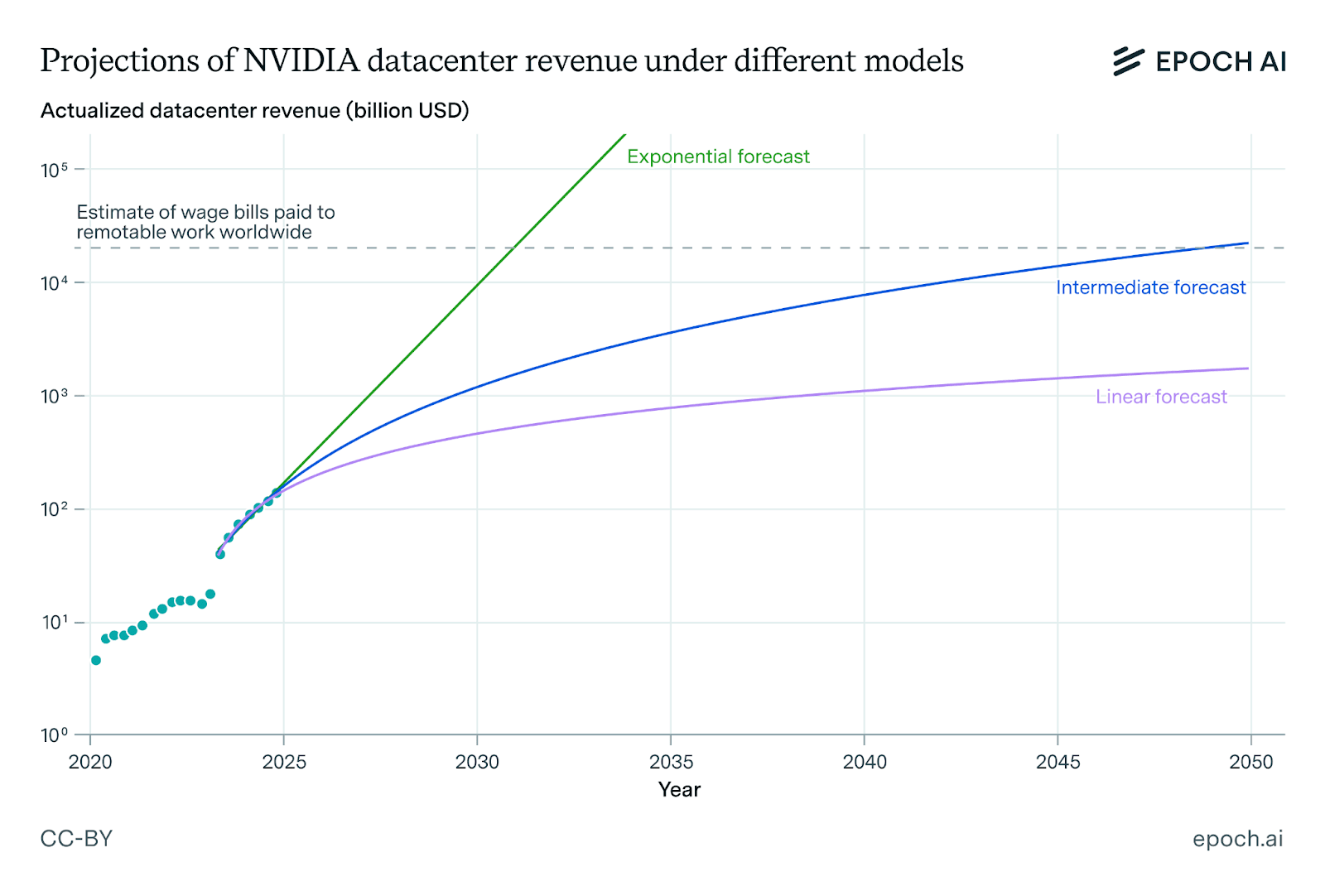
A plot of AI datacenter revenue shows that if the trend continues even as far as 2030, the entire economy would be transformed.
But what would a realistic trajectory actually be? How can we know what trajectory we’re on? The current growth rate is very weak evidence of how fast growth can be sustained after a further order of magnitude increase.
A more grounded approach would be to analyze a historical episode of explosive growth, identify the key mechanism, and then estimate the extent to which the same mechanism is operating today. We can make comparisons to how the complete trajectory played out, from beginning to end.
By far, the best studied episode of a major growth acceleration is the Industrial Revolution. Economic historians have long sought to elucidate the Industrial Revolution’s origins in Britain; over decades, they have compiled extensive data on Britain’s economic growth.
A recent paper in the Quarterly Journal of Economics (Bouscasse, Nakamura, and Steinsson, 2025) provides perhaps the most credible model of Britain’s economic trajectory yet. By rigorously estimating a unified model of economic growth against centuries of carefully assembled historical data, the authors reveal insights into the timing and nature of Britain's transition to modern economic growth.
Notably, by combining (1) a flexible growth model that accommodates structural change, and (2) aligned time series data on land rents and capital stock, the authors were able to explain the Industrial Revolution’s explosive GDP growth as due in large part to structural change in land dependency rather than structure-preserving productivity growth.
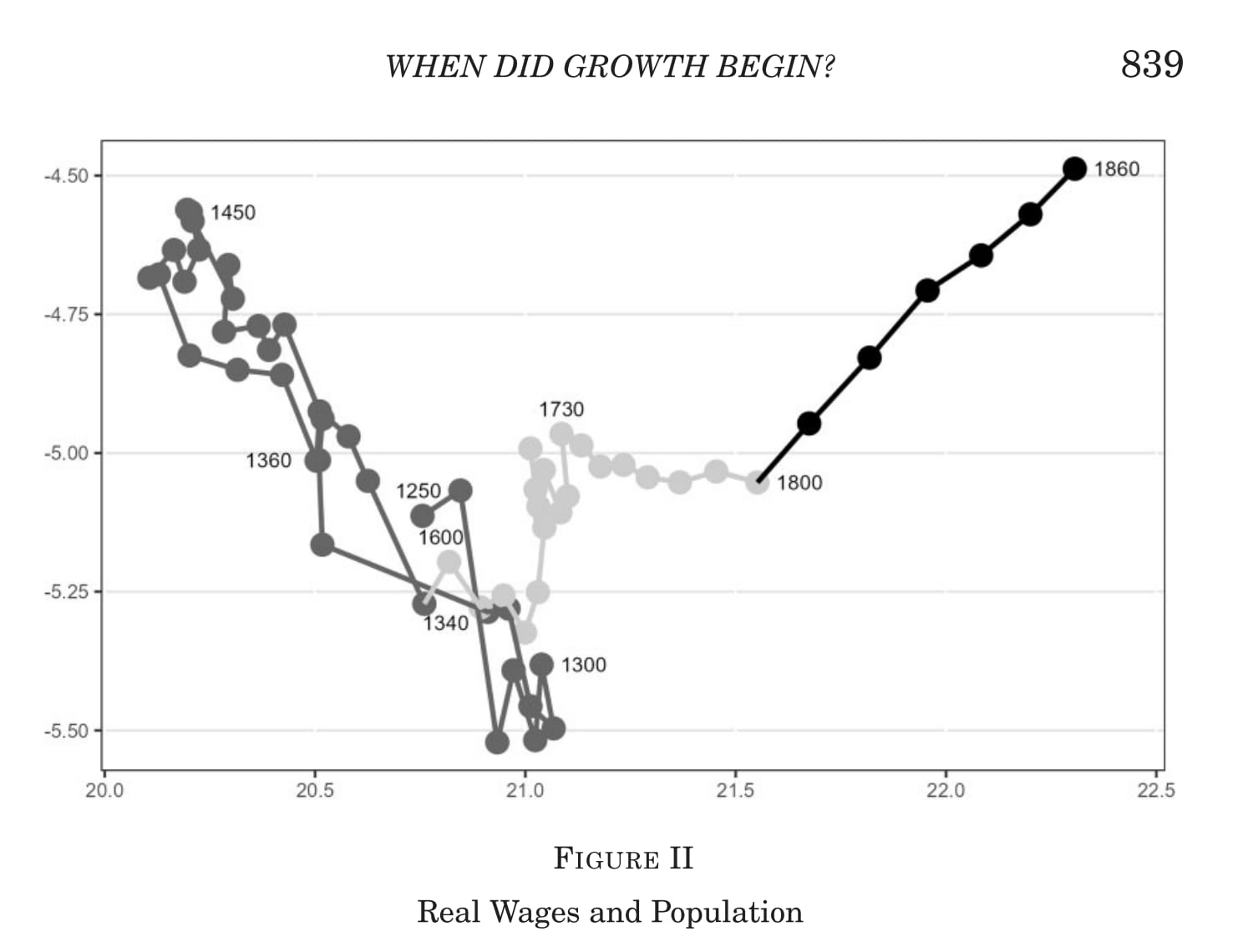
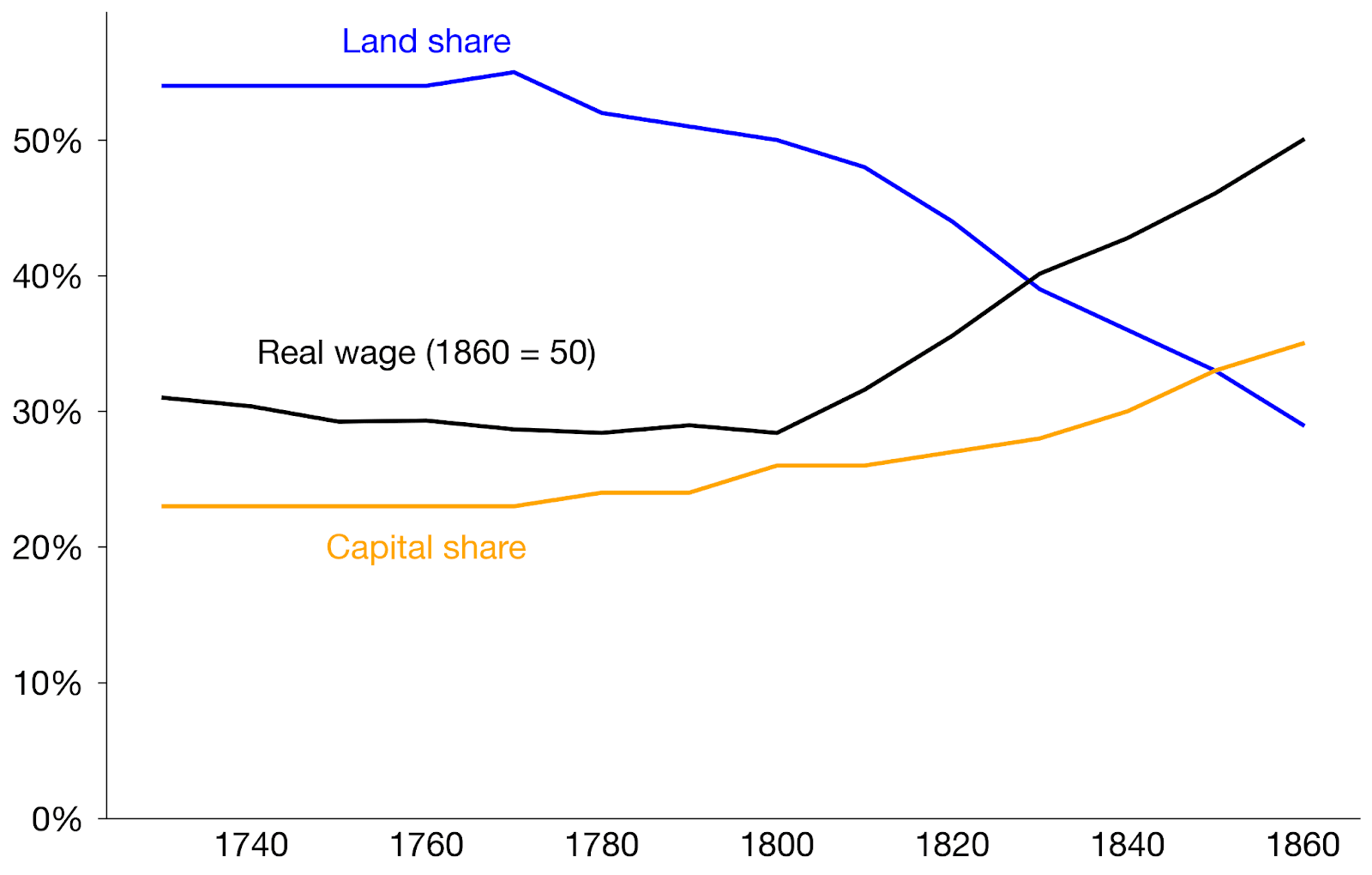
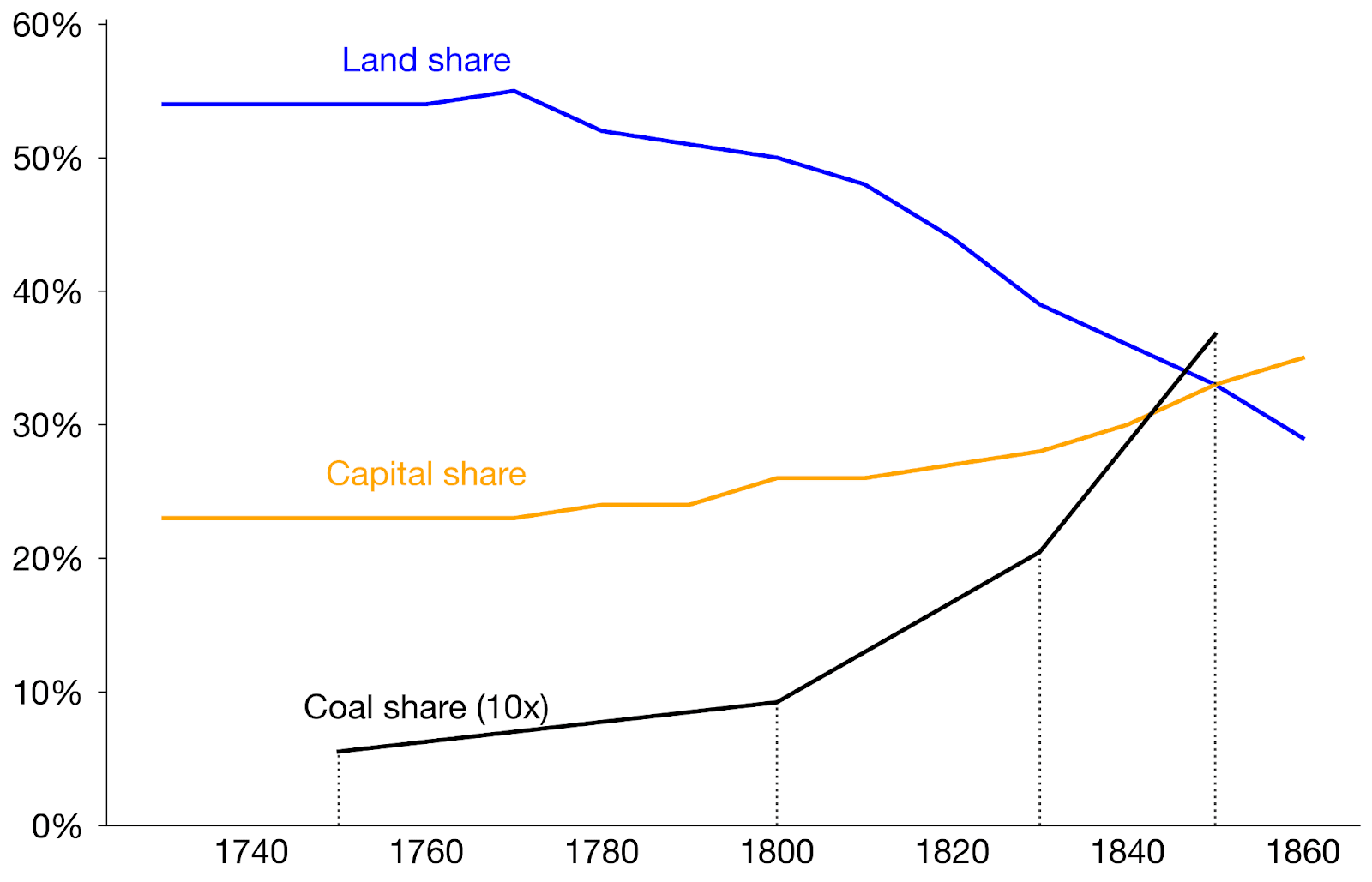
In their data, population and wages and capital stock all grew quickly from 1750 onward. With a preindustrial economic structure, this would make land much more relatively scarce, and land rents would soar. But instead, land rents were close to flat. So land must have become less critical.
The obvious explanation for the post-1750 liberation from land dependency is the rise of steam power and the rapid substitution of coal for organic energy and agricultural land. As it happens, the growth explosion, the structural transformation, and the rise of steam power were all closely aligned in timing.
Their overall picture of the Industrial Revolution is consistent with the following model:
- From 1600 to 1800, a new and innovative sector (cities and proto-industry) grew, but was held back by a traditional bottleneck (land).Around 1800, a new technology (steam) enabled rapid substitution out of the traditional bottleneck, and growth exploded.
What does this mean for AI?
It’s tempting to draw a parallel between the Industrial Revolution and today’s events, in which a new technology is spurring unprecedented growth in the information sector and prompting leading companies to disinvest in labor — today’s inelastic factor of production — in favor of the new technology’s demands.
It’s not so simple, however, because unlike in the Industrial Revolution with land, the labor share has not declined much in the 2020s so far. We should not pretend to know what AI will do to the economy. Compared to agricultural land, the uses for labor are extremely diverse; the economy could continue to depend on labor in the AI supply chain, in complementary sectors, or in sectors such as health care that grow especially fast in demand with income.
The key question is about “AI takeoff”: whether AI will become independent of labor and create explosive growth.
Define the “AI sector” as all the services directly performed by AI systems, whether intangible or embodied. Then:
- In the extreme case where the AI sector is 100% of the economy and has zero labor dependency, per capita GDP should be able to grow arbitrarily large, since the scale of the economy can be totally independent of population.More generally, as long as the AI sector (1) grows to be a large majority of gross value added, and (2) has minimal labor dependence, economic growth will be far less constrained than today.
Uncertainty about AI’s trajectory can mechanically be decomposed into two questions:
- [Sector growth] Can the AI sector grow to become a large portion of gross value added?
- Growth is certainly fast today, but AI’s current share is small, and the ultimate limit is unknown.
- (Technically, the AI sector could also be independent of labor if labor has a high elasticity of substitution with other inputs. But in practice this should be observable as a low labor share, since labor will be substituted away from.)
Many, many people are already tracking AI’s growth. But as far as I know, no one serious has tried to estimate the supply chain’s labor intensity, and certainly not how it is changing over time. I think it is a very important question!
And compared to many AI economics topics, I suspect that supply chain labor intensity can be an especially tractable research question. This is for two reasons:
- It can be estimated without making necessarily-very-uncertain assumptions about future AI capabilities. It is purely a question about the present day.It is a question that can benefit from many independent contributions. Each component of the supply chain for AI services — from application development, chip design, fabrication, semicap, and datacenter construction, to electricity generation — can be researched in parallel.
Notes
- The AI takeoff question is distinct from “will AI push wages to zero”, which should only happen if an inelastic factor such as natural resources causes the economy to experience decreasing returns to scale.The idea that substituting labor will produce explosive growth is certainly not new. Erdil (2023, 2025) pointed out that automation of any substantial fraction of tasks will greatly boost growth. The new idea here is that the labor intensity of today’s AI sector is important to try to measure.It is theoretically possible for AI to substitute for labor in most tasks but be so expensive to build and so slow in productivity growth that economic growth does not accelerate much. Considering the rate of progress in AI, I consider this very unlikely.
Additional parallels with the Industrial Revolution:
The 1600-1800 period parallels the “pre-AI information age” of modern times (1970-2022). A limited amount of structural transformation took place (then, a shift from agriculture into proto-industry; now, software industry growth & labor share decline) but the economy remained primarily constrained by a traditionally fixed factor (then, land; now, labor). At the same time, macroeconomic changes greatly boosted eventual demand for the enabling technology (then, high energy demand and abundant industrial skills; now, high labor demand and abundant data).
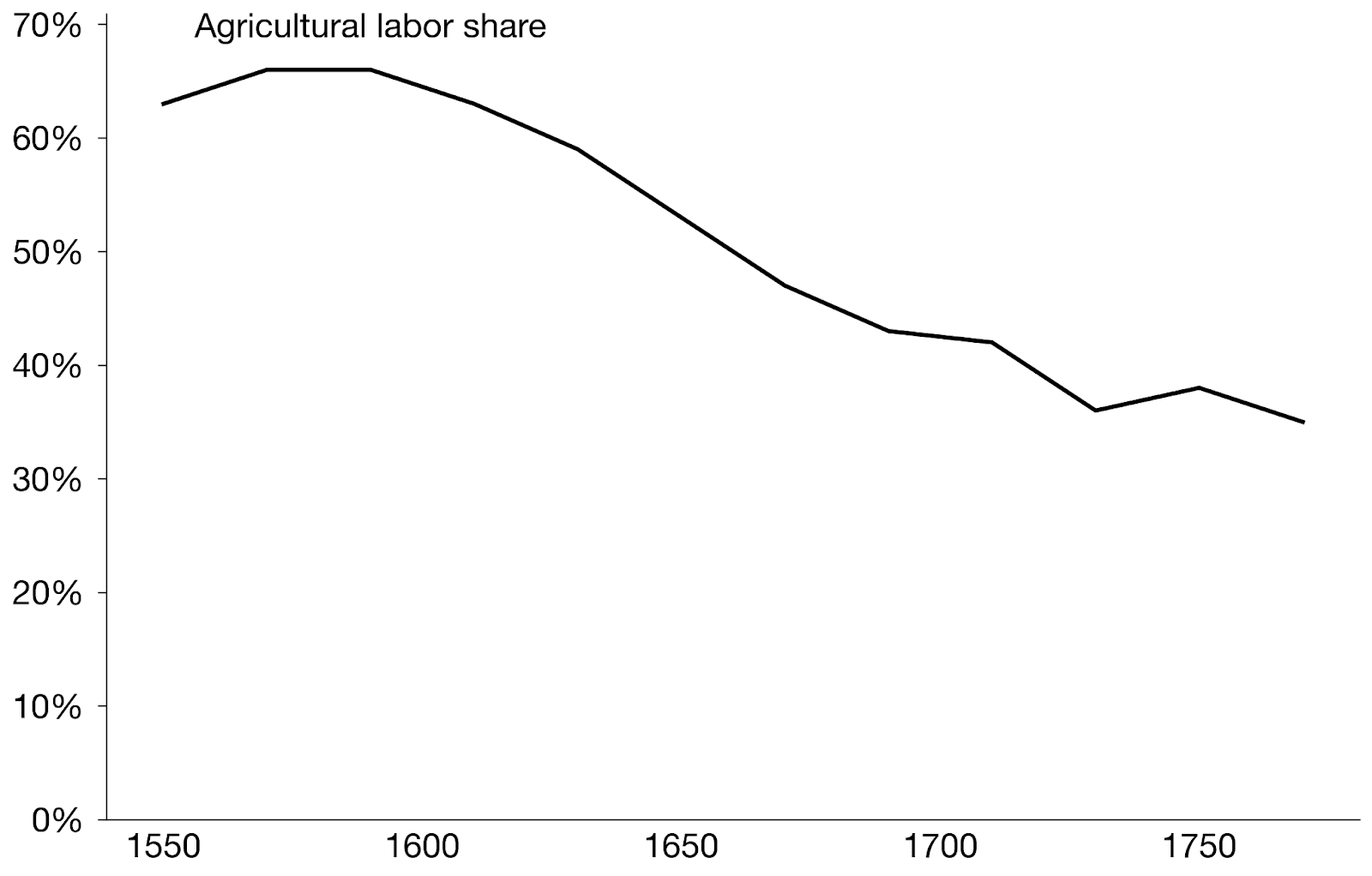
- Compatible
- AI 2027 (race scenario) — since it involves the rapid growth of a robot-only economy“Normal technology” views — the authors make many points about how it will be difficult and slow for AI to truly replace labor, but they do not explicitly say that the labor share of income will remain high. Growth via substitution does not imply any particular speed of substitution.
- “Kaldor’s facts” — substitution implies that the labor share does not stay similar.
- Compare the Industrial Revolution (which structurally changed the importance of land) to the Neolithic Revolution (which was an equally large increase in productivity, but did not make land less important).
Discuss

